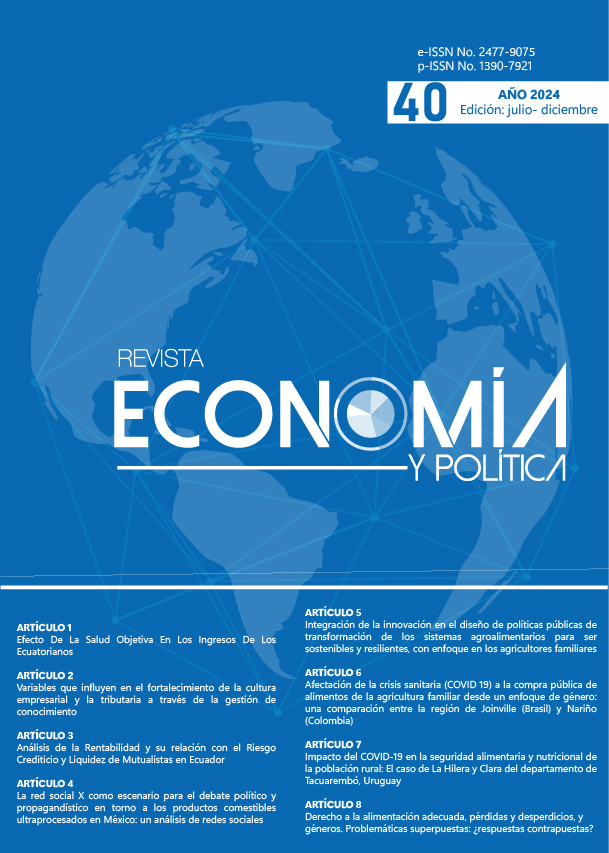Efecto de la Salud Objetiva en los ingresos de los ecuatorianos
DOI:
https://doi.org/10.25097/rep.n40.2024.01Palabras clave:
Salud, Ingresos, Modelo de Mincer, Modelo de GrossmanResumen
Basándose en la teoría del capital humano, los ingresos dependen de la educación, experiencia y salud. Aquí estudiaremos el efecto que tiene la salud en los ingresos de los individuos del Ecuador. Para lograrlo, se emplea variables instrumentales y ecuaciones simultaneas en la ecuación de Mincer (1974) ampliada, y el modelo de Grossman (1972). La información se obtuvo de la encuesta condiciones de vida 2013-2014 y los parámetros se estimaron por mínimos cuadrados en dos etapas, método generalizado de momentos y mínimos cuadrados en tres etapas. Los resultados muestran que un mal estado en la salud tiene un efecto negativo en los ingresos personales, siendo un impacto mayor en el género masculino. Así mismo, afecta más a la gente de la región sierra y a los trabajadores independientes.
Descargas
Citas
AARP. (2015). AARP. Obtenido de aarp.org: https://www.aarp.org/espanol/salud/expertos/elmer-huerta/info-2015/enfermedades-cronicas-personas-mayores.html
Alleyne, G., Cohen, D. y Sachs, J. (2003). Salud, Crecimiento Económico y reduccion de la pobreza. Comisión sobre Macroeconomía y salud. Washington, D.C.: Organizacion mundial de la salud.
Arias , F. y Tovar, L. (2005). Determinantes del estado de salud de la población colombiana. Documento de trabajo Nº 82, Cali. Obtenido de http://bibliotecavirtual.clacso.org.ar/Colombia/cidse-univalle/20121116041140/doc82.pdf
Barragán, L., Garcia, J., y Garcia , F. (2009). Estimación de la Tasa Interna de Retorno a la Educación en el Ecuador. Guayaquil, Ecuador.
Basman, R. (1960). On finite sample distributions of generalized classical linear identifiability test statistics. Journal of the American Statistical Association, 55(292), 650-659.
Baum, C. F., Wiggins, V., Stillman, S., Schaffer, M. E. y Windmeijer, F. (1999). OVERID: Stata module to conduct postestimation tests of overidentification. Statistical Software Components. https://ideas.repec.org/c/boc/bocode/s396802.html
Becker, G. S. (1962). Investment in Human Capital: A Theoretical Analysis. Journal of Pilitical Economy, 70(5), 9-50.
Becker, G. (1964). Human Capital. (1a ed.) New York: Columbia University Press.
Becker, G. (1983). El Capital Humano. (2a ed.). Madrid, España: Alianza Editorial S.A.
Blackburn, M. y Neumark, D. (1992). Unobserved Ability, Efficiency Wages, and Interindustry Wage Differentials. Oxford Journals, 107(4), 1421-1436.
Borja Plaza, L. (2020). El Quantificador. Obtenido de https://elquantificador.org/post/economia/ecuatorianos-mas-altos-ganan-mas/
Botello, H. A. y Guerrero, I. (2017). Efectos de las caractoristicas físicas en los ingresos laborables del Ecuador, 2012. Semestre Económico, 20(42), 127-142.
Boussalem, F., Boussalem, Z. y Taiba, A. (2014). The Relationship between public spending on health and economic growth in Algeria: Testing for Co-integration and Causality. International Journal of Business and Management, 2(3), 25-39.
Bowles, S. y Gintis, H. (1985). La instrucción escolar en la América Capitalista (2a ed.). Madrid: Siglo XXI.
Boyce, C. y Oswald, A. (2012). Do People Become Healthier After Being Promoted? Health Economics, 580-596.
Brazenor, R. (2002). Disabilities and Labour Market Earnings in Australia. Australian Journal of Labour Economics, 5(3), 1328-1143.
Brown, S., Roberts, J. y Taylor, K. (2010). Reservation wages, labour market participation and health. Journal of the Royal Statistical Society, 173(3), 501-529.
Burgess, S., Propper , C. y Rigg, J. (2004). The Impact of Low Income on Child Health: Evidence from a Birth Cohort Study. London, UK: Centre for Analysis of Social Exclusion, London School of Economics.
Cai, L. (2009). Effects of Health on Wages of Australian Men. The Economic Record, 85(270), 290-306.
Cameron, A. C. y Trivedi, P. K. (2005). Microeconometrics: Methods and Applications. New York: Cambridge University Press.
Canicoba, H. (2013). Sesgo de selección y brecha salarial de género para Lima Metropolitana. Revista del instituto de investigación de la facultad de ciencias económicas, 43-53.
Card, D. (1999). The Causal Effect of Education on Earnings. En D. Card, Hanbook of Labor Economics (Vol. 3, págs. 1801-1863).
Chen, Y. y Li, H. (2008). Mother’s Education and Child Health: Is There a Nurturing Effect? Journal of Health Economics, 28(2), 413-426.
Cislaghi, B. y Cislaghi, C. (2019). Self-rated health as a valid indicator for health-equity analyses: evidence from the Italian health interview survey. https://doi.org/10.1186/s12889-019-6839-5
Contoyannis, P. y Rice, N. (2001). The impact of health on wages: Evidence from the British Household Panel Survey. Empirical Economics, 26, 599-622.
Doeringer, P. y Piore, M. (1971). Analysis, Internal Labor Market and Manpower Analysis. New York: ME Sharpe.
Flores, M., Fernández, M. y Pena-Boquete, Y. (2020). The impact of health on wages: evidence from Europe before and during the Great Recession. Oxford Economic Papers, 319-346.
Forbes, M., Barker, A. y Turner, S. (2010). The Effects of Education and Health on Wages and Productivity. Autralia: The Productivity Commission.
Forgel, R. (1991). New sources and new techniques for the study of secular trends in nutritional status, health, mortality and the process of aging. National Bureau of Economic Research. Working Paper Series as Historical N° 26.
Forgel, R. W. (1994). Economic Growth; population theory and physiology. American Economic Review, 84(3), 369-395.
Forgel, R. W. (2000). The Fourth Great Awakening and the Future of Egalitarianism. Journal of Interdisciplinary History, 33(2), 322-325.
Fuchs, V. R. (1966). The Contribution of Health Services to the American Economy. The Milbank Quarterly, 44(4), 1111-1112.
Gambin, L. M. (2005). The impact of health on wages in Europe – Does gender matter?
Ghatak, A. y Madheswaran, S. (2014). Impact of Health on Labour Supply and Wages: A Case of Agricultural Workers in West Bengal. Journal of Health Management, 441-461. Obtenido de ResearchGate.
Girón Daviña, P. (2010). Los determinantes de la salud percibida en España. España.
Gómez, E., Bolaños, E., Riascos, T. y César, J. (2016). La educación y el ingreso como determinantes de la esperanza de vida en colombia - 2002-2012. Revista de la Facultad de Ciencias Económicas y Administrativas, 17(2), 31-55.
González, C., Mora, J. y Verdú, C. (2015). Corrección del sesgo de selección muestral en la probabilidad de demandar educación universitaria en Colombia. Cali, Colombia.
Gordon, D., Edwards, R. y Reich, M. (1982). Segmented Work, Divided Workers: The historical transformation of labor in the United States. New York: Cambridge University Press.
Greene, W. (1999). Análisis Econométrico (3ra ed.). Madrid, España: Pearson.
Greene, W. (2011). Econometric Analysis. New York: Pearson Education Limited. Obtenido de http://pages.stern.nyu.edu/~wgreene/Text/econometricanalysis.html
Grossman, M. (1972). On the Concept of Health Capital and the Demand for Health. The Journal of Political Economy, 80(2), 223-255.
Grossman, M. (1989). Health Benefits of Increases in Alcohol and Cigarette Taxes. British Journal of Addiction, 84(10), 1193-1204.
Guizar, A. (2007). Los retornos a la educación y a la productividad del trabajo en Mexico ¿hay un efecto Seeepskin?
Gujarati, D. (2004). Econometría (Cuarta ed.). (D. Garmendia, y G. Arango, Trads.) New York: McGraw-Hill Interamericana.
Halla, M. y Zweimüller, M. (2013). The Effect of Health on Income: Quasi-Experimental Evidence from Commuting Accidents. Labor Economics, 24(C), 23-48.
Hansen, L. P. (1982). Large Sample Properties of Generalized Method of Moments Estimators. Econometrica, 50(4), 1029–54. Obtenido de https://doi.org/10.2307/1912775
Hartwig, J. y Sturm, J.-E. (2018). Testing the Grossman model of medical spending determinants with macroeconomic panel data. The European Journal of Health Economics, 19, 1067–1086, https://doi.org/10.1007/s10198-018-0958-2
Hayashi, F. (2000). Econometrics. Princeton: Princeton University Press.
Heckman, J. (1979). Sample Selection Bias as a Specification Error. Journal of the Econometric Society, 47(1), 153-161.
Heckman, J., Lochner, L. y Todd, P. (2003). Fifty Years of Mincer Earnings Regressions. Obtenido de The National Bureau of Economics Research: https://www.nber.org/papers/w9732
Miilunpalo, S., Vuori, I., Oja, P., Pasanen, M. y Urponen, H. (1997). Self-rated health status as a health measure: The predictive value of self-reported health status on the use of physician services and on mortality in the working-age population. Journal of Clinical Epidemiology, 50(5), 517-528.
Mincer, J. (1958). Investment in Human Capital and Personal Income Distribution. Journal of Political Economy, 66(4), 281-302. Recuperado el 2 de 02 de 2020, de https://www.jstor.org/stable/1827422
Mincer, J. (1974). Schooling, experience and earnings. Columbia University Press.
Jäckle, R. y Himmler, O. (2010). Health and Wages: Panel Data Estimates Considering Selection and Endogeneity. The Journal of Human Resources, 45(2), 364-406.
Lenhart, O. (2018). The effects of income on health: new evidence from the Earned Income Tax Credit. (Springer, Ed.) Rev Econ Household, https://doi.org/10.1007/s11150-018-9429-x
Li, R., Chen, X., Yan, H., Deurenberg, P., Garby, L. y Hautvast, J. (1994). Functional consequences of iron supplementation in iron-deficient female cotton mill workers in Beijing, China. The American Journal Clinical nutrition, 59(4), 908-913.
López, J. y Sarmiento, G. (2019). Determinantes de la brecha salarial en Ecuador: análisis bajo un modelo minceriano relacionado con variables agregadas dummy. Revista multidisciplinaria de invesitgación científica.
Martínez, G. (2018). Cada quien es diferente: El efecto de la salud sobre los ingresos laborales. Sobre México. Temas en Economía, 4(1), 4-21.
Massimo, F. y Suchita, S. (2019). Investments in worker health and labor productivity: Evidence from Vietnam, ECONSTOR, http://hdl.handle.net/10419/207148
McConnell, C. R., Brue, S. L. y Macpherson, D. A. (2015). Contemporary Labor Economics. New York: McGraw Hill.
Merlo, J. J. (2009). Retornos a la educación durante una depresión económica. Evidencia empírica para la Argentina. Santiago, Chile.
Ministerio del Trabajo. (2022). Boletín estadístico anual: el mercado laboral en el Ecuador 2022. Quito: Ministerio de trabajo.
Pindyck, R. S. y Rubinfeld, D. L. (1991). Econometric Models and Economic Forecasts (3a ed.). New York: McGraw-Hill.
Ribero, R. y Nuñez, J. (2002). Adult Morbidity, Height and Earnings in Colombia. Wealth from health. Linking social investments to earnings in Latin America. Washington D.C.: Latin American Research Network – Interamerican Development Bank.
Sapelli, C. (2003). Ecuaciones de Mincer y Tasa de Retorno a la Educación en Chile 1990-1998. Obtenido de ResearchGate: https://www.researchgate.net/publication/5128701_Ecuaciones_de_Mincer_y_las_Tasas_de_Retorno_a_la_Educacion_en_Chile_1990-1998
Schultz, T. (1960). Capital formation by education. The journal of political economy, 68(6), 571-583.
Schultz, P. y Tansel, A. (1997). Wage and labor supply effects of illness in Côte d'Ivoire and Ghana: instrumental variable estimates for days disabled. Journal of Development Economics, 53(2), 252-286.
Schultz, T. (2002). Wage Gains Associated with Height as a Form of Health Human Capital. The American Economic Review, 92(2), 349-353.
Sengupta, K. (2017). Health and Its Impact on Labour Productivity and Labour Market. International Journal of Health and Medicine, 2(1).
Solow, R. (1957). Technical Change and the Aggregate Production Function. The Review of Economics and Statistics, 39(3), 312-320.
Stock, J. H. y Yogo, M. (2011). Asymptotic Distributions of Instrumental Variables Statistics with Many Instruments (September 10, 2004). Identification and inference for econometric models: essays in honor of Thomas Rothenberg, Ch. 6, 2005, Available at SSRN: https://ssrn.com/abstract=1734937
Strauss, J. y Thomas, D. (1998). Health, Nutrition, and Economic Development. Journal of Economic Literature, 36(2), 766-817.
Tarupi Montenegro, E. (2015). El capital humano y los retornos a la educación en el Ecuador. Revista Internacional de Administración, 81-94.
Taubman, P. y Wales, T. (1974). Higher Education and Earnings: College as an Investment and Screening Device. Eduaction as an Screening Device, 153-174.
Terris, M. (1980). Tres Sistema Mundiales de Atención Médica. Cuadernos Medicos Sociales, 14, 27-35.
Thomas, D., Strauss , J. y Henriques, M. H. (1991). How Does Mother's Education Affect Child Height? Journal of Human Resources, 26(2), 183-211.
Thurow, L. (1975). Generating Inequality: Mechanisms of Distribution in the U. S. Economy. New York: Basic Books.
Trávez Monge, A. (2016). Capital Humano y Tasa de retorno de la Educación para Ecuador durante el periodo 1990-2014.
Villacreses Zúñiga, D. D. (2015). Caracterización de la demanda de servicios de salud en el Ecuador. Una aplicación empírica. Quito, Ecuador.
Villalobos Dintrans, P. (2007). ¿Cómo Afectan a los Salarios Distintas Dimensiones de la Salud? ¿Cómo Afectan a los Salarios Distintas Dimensiones de la Salud? Santiago, Chile.
Weil, D. N. (2007). Accounting for the Effect of Health on Economic Growth. The Quarterly Journal of Economics, 122(3), 1265-1306.
Weil, D. W. (2015). A Review of Angus Deaton's The Great Escape: Health, Wealth, and the Origins of Inequality. Journal of Economic Literature, 53(1), 102-114.
WHO. (2015). WHO Library Cataloguing-in-Publication Data.
Willis, R. (1986). Chapter 10 Wage determinants: A survey and reinterpretation of human capital earnings functions. En R. Willis, Handbook of Labor Economics (págs. 525-602). Chicago.
Wooldridge, J. (2010). Introducción a la econometría, un enfoque moderno (4ta ed.). (M. Hano, y É. Jasso, Trads.) Michigan, USA: CENGAGE Learning.
Publicado
Cómo citar
Número
Sección
Licencia
Derechos de autor 2024 Revista Economía y Política

Esta obra está bajo una licencia internacional Creative Commons Atribución-NoComercial-CompartirIgual 4.0.






